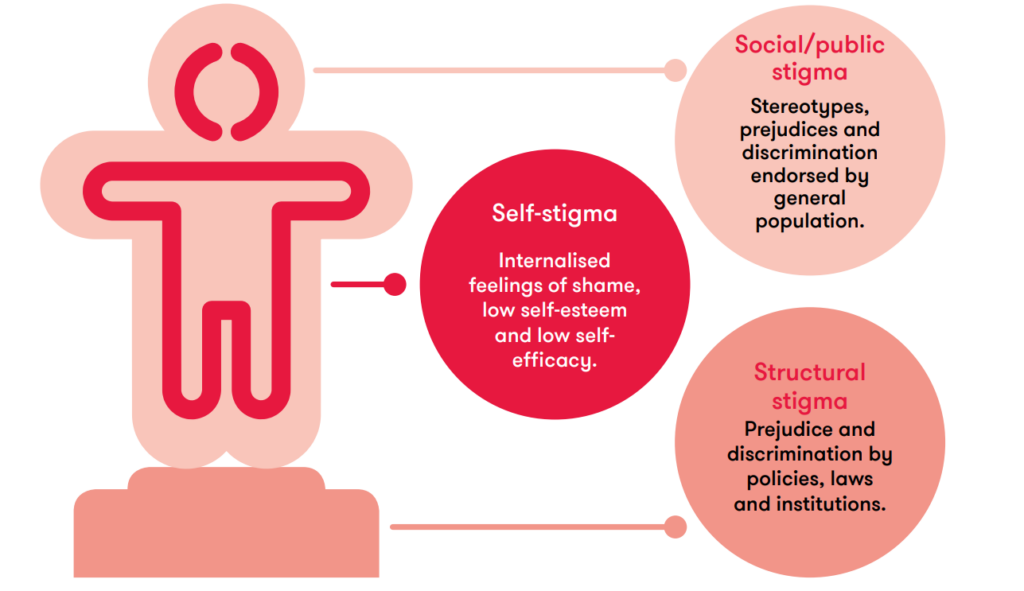Ending the Stigma and Why it is Important
What is Stigma?
Stigma is any negative attitude or behavior toward a person or group because of the belief that a characteristic or behavior is shameful. This form of discrimination asserts that because of this stigmatized characteristic or behavior, a person is bad, dangerous, and/or weak.
There are three main types of stigma:
- self-stigma
- social/public stigma
- and structural stigma.
The figure below describes these stigmas and different ways that stigma is expressed.

Why Does Stigma Matter?
It’s important to understand stigma because stigma creates barriers to health and well-being – from changing a person’s view of themself and what choices they feel comfortable making, to how they’re treated by society and systems. The consequences of these barriers are significant. Stigma can impact trust, community support, health, and other important resources to recovery.
Substance use stigma, specifically, can have negative impacts on:
- Access to treatment
- Recovery and support
- Physical and mental health
Impact of Stigma on Treatment
Judgements and misconceptions around treatment can affect the kind of care people choose, or even whether they seek treatment at all. It can also lead people to hide their substance use disorder and avoid seeking support.
Stigma also impacts people who are in treatment. Although medication is a highly effective tool in recovery, there is still stigma around medically assisted treatment (MAT) and the use of medications such as methadone and buprenorphine. These medications lessen cravings for opioids, help with withdrawal symptoms, and help people to stay in treatment.
Impact of Stigma on Other Resources to Recovery
Stigma affects access to other key supports like funding, supportive relationships, housing, and employment. Although addiction is a treatable disease and not a moral failing, individuals with substance use disorder are often treated without empathy, kindness, or consideration for a physical disease. Stigma can limit access to supports and isolate people from the help they need in their path to recovery.
Ways to Reduce Stigma
Stigma can be reinforced by misconceptions, lack of knowledge, and judgmental language. One way to reduce stigma is by first examining your own perspectives, opinions and experiences related to people who use drugs. By becoming more aware of your own biases, you can be better prepared to acknowledge and address stigma in your conversations, in your relationships, or in your work.
Address Common Misconceptions and Stereotypes
False: Addiction is caused by a lack of willpower and morality.
True: Substance use disorder is a complex, chronic disease that can be really hard to address through willpower alone. It changes a person’s brain chemistry in a way that causes strong cravings and dependency. This physical dependence on opioids can drive a person to compulsively use drugs, in spite of harmful consequences and decreasing pleasure from the substance. This physical dependency is why MAT is such a powerful resource in recovery.
False: Relapse is a failure.
True: Relapse is another part of recovering from substance use disorder. It’s a common step that many people experience on their path to recovery, and relapse does not mean someone is unable to recover.
False: Paraphernalia like naloxone (Narcan) and fentanyl test strips support addiction.
True: Harm reduction strategies are important tools that help build trust and can support recovery. These strategies are a way of recognizing the complexity of substance use disorder and providing people who use drugs with tools to stay safe.
To learn more about drug use and addiction, visit: Understanding Drug Use and Addiction DrugFacts | National Institute on Drug Abuse (NIDA) (nih.gov)
Understand the Power of Language
Language is powerful. It can shape views and opinions on substance use. The ideas and feelings that words provoke, along with the meaning of the words themselves, have the power to either reinforce or reduce stigma. Using empathetic language is an opportunity to support people who are experiencing substance use disorder and to reduce harm caused by judgmental language.
When we change our language to non-stigmatizing comments, we can begin to change the public conversation around substance use disorder and help decrease barriers to health and recovery. This can require retraining ourselves to use different language than we’ve used in the past, or different language than we hear from those around us, but it can make a big difference to people in our community who are struggling with substance use disorder or who have a loved one struggling with it.
The following graphic highlights ways to use inclusive language.
References
- Wogen, J., & Restrepo, M. T. (2020, June). Human rights, stigma, and substance use. Health and Human Rights Journal. Retrieved September 21, 2021, from https://www.hhrjournal.org/2020/06/human-rights-stigma-and-substance-use/.
- Medication-assisted treatment (MAT). SAMHSA. (2021, September 16). Retrieved September 21, 2021, from https://www.samhsa.gov/medication-assisted-treatment.

